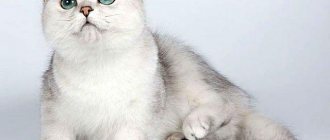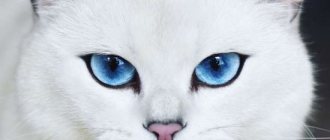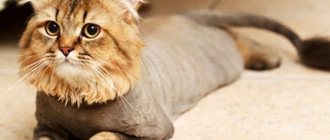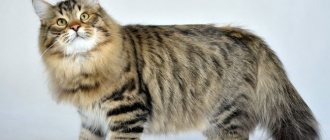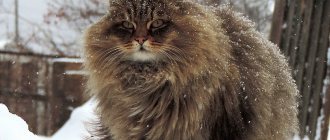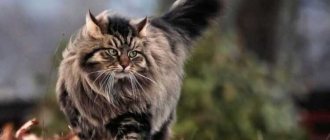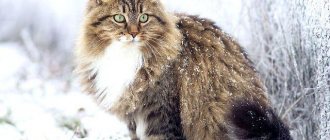Description of the Siberian cat breed
Popularity 6th place among 86 cat breeds
Lifespan:
17-20 years old
Height:
males: 40 cm, females: 30 cm
Country of origin:
Russia
Average price:
5-20 thousand rubles
Weight:
3.5-12 kg
Latest articles Cat care
How to trim a cat's claws correctly and easily 01/28/2022 139 0 0
Dog health
How to do an ultrasound for dogs: preparation and procedure 01/28/2022 63 0 0
Bathing
Before washing, comb the animal well.
Place a towel or rubber mat in a small basin. This prevents your pet's paws from slipping while bathing. The water temperature is approximately 38-39 degrees Celsius, the level is approximately 8-10 cm. The animal is placed in a basin, there is no need to immediately pour water on it, first the wool is soaked with water, using a sponge and not touching the head area. If the cat becomes very nervous during this first wash, do not make sudden movements or turn on the water or shower too much. Close the bathroom door to prevent the animal from escaping.
The washing itself is done with shampoo, which is different for each cat (the choice is individual and depends on the breed and color). To rinse off the shampoo, use warm water and a mug or ladle (shower heads can frighten the cat). After bathing, the pet should be wrapped in a warm, dry cloth (towel) and dried. It is better not to dry the animal with a hairdryer, because the noise of the device can frighten it, which will lead to nervous shock to the cat and it can injure and scratch the owner. It is better to calm the animal during the procedure, pet it and talk to it. The procedure should be performed by the owner whom the cat trusts most. A cat can dry itself after bathing only in a warm place; drafts must be excluded, otherwise it will catch a cold. Keep an eye on this. You need to wash your cat as it gets dirty, it depends on whether it walks outside; frequent washing is contraindicated. If your pet is only at home, you can carry out water procedures 2-3 times a year.
The Siberian cat will become an excellent friend to your family, however, its fur requires some care, and when getting such a pet you must be prepared for this.
Key facts
The Siberian cat is an animal with a magnificent appearance and luxurious thick fur, which has long been popular not only in its country of origin - Russia - but also far beyond its borders. The description of the Siberian cat breed suggests a second name - Siberian forest cat.
These pets combine completely opposite qualities: massiveness and grace, tenderness and love of freedom, playfulness and the desire to be alone.
Endowed with enormous energy and good health, cats of this breed are prone to longevity. The lifespan of a Siberian cat is about 15-17 years. Their sizes range from medium to very large. For example, females usually weigh 4-8 kg, while males weigh 6-12 kg.
Clever and brave, Siberians get along well in families with children or other pets. They will be good companions for older people, as they are quite independent, tactful and not annoying. Reviews from owners of Siberian cats indicate their cleanliness and accuracy.
Pros and cons of the breed
The table lists the advantages and disadvantages of Siberian cats:
| pros | Minuses |
| Spectacular appearance | The need for regular grooming |
| Friendly character | Willfulness and obstinacy |
| Agreeableness | Aggressiveness |
| Tact | Aversion to loneliness |
| Sociability | Proud disposition |
| Developed intelligence | Tendency to play pranks |
| Calm and poise | Susceptibility to mood swings |
| Caution | Excessive curiosity |
| Loyalty to the owner | Excessive independence |
This characteristic is conditional and gives a generalized idea of the breed. Heredity and the purely individual qualities of the baby play a significant role.
Proper upbringing and caring care will be the key to strong friendship and many years of happy communication with this amazing creature!
History of the origin of the Siberian cat
The image of a large hunter cat from Russian folk tales fits the description of the Siberian cat perfectly. It is unknown at what time these majestic animals appeared, but it seems that they have always been on the territory of our country.
For a long time, all cats with long hair were called Siberian, without even thinking about where this name came from. Only in the 80s of the last century did breeders think about the ancestors of this popular cat.
Disputes began about the origin of the breed. One theory claims the Scandinavian roots of Siberians. It is assumed that Norwegian forest cats took part in the birth of our giants. They could have appeared in Siberia along with settlers during the development of new territories at the beginning of the 16th century.
Indeed, in those days there appeared written references to strong shaggy cats, common in different regions of Russia. They were then called Bukhara cats. It is said that they were brought from Asian countries by Russian merchants. Supporters of this version suggest further mixing of the Bukhara breed with local wild Siberian manul cats.
Some felinologists do not deny the participation of Persian cats in the development of Siberians. Persian individuals could have entered our regions along with travelers along the famous Silk Road.
There are scientists who do not recognize the independence of the Siberian cat breed. They simply call them large cats with thick, non-white hair.
An interesting fact is that during the siege of Leningrad during the Great Patriotic War, almost all cats were destroyed. By the end of the siege in 1943, the city was overrun by rats, spreading infections and spoiling food. After the breakthrough, trains of cats were sent from different cities of the Soviet Union to the undefeated city. They arrived, among others, from the Siberian cities of Omsk and Tyumen, as well as from Irkutsk.
Conscious development and improvement of the breed began in 1986 in nurseries in Moscow and Leningrad. The largest and fluffiest animals were taken as a basis. No one went to Siberia for them - they took local strong cats.
At the end of the last century, the situation changed: cats from the territory of Siberia and the Far East were attracted to selection, differing from their relatives in their powerful bones, massive heads, and hard coat. Thanks to this work, it was possible to breed a truly Russian breed of true Siberian big guys.
In 1991, the standards of the Siberian breed, developed by felinologist Olga Mironova, were recognized by the World Cat Federation. Three years later, these characteristics were recognized by all international organizations.
Currently in our country there are quite a lot of well-known nurseries for breeding Siberian cats. Most of them are located in Moscow and St. Petersburg, but these magnificent animals are also bred in Saratov, Krasnoyarsk, Kirov, Kursk, and Yekaterinburg. The work on fixing various colors does not stop. Thus, one of the last cat colors was “Neva Masquerade”.
Nutritional Features
Unfortunately, the domestic Siberian cat is deprived of natural sources of nutrition and is completely dependent on the owner for this. She should be fed only in the designated area, and the food bowl should be stable and not too deep. After finishing the meal, you need to remove any leftover food and wash the bowls, otherwise your cat may get an upset stomach or poisoning.
Feeding a cat requires special attention. If her diet is a matter of her whim or consists of only leftovers, it will end in metabolic disorders. Feeding correctly means choosing a diet in which nutrition will contribute to the formation of the skeleton, normal metabolism, hair growth and will become a source of strength and vigor. What to feed a Siberian cat and what size of portions are determined by the age, condition of the animal and whether you have a cat or a she-cat.
Feeding Siberian cats is based on the following rules:
- the portion is the correct size if your cat is moderately well-fed and does not look skinny or overfed;
- you need to feed with enough variety, and most importantly with properly balanced foods;
- An adult cat prefers to eat what he ate when he was a kitten. If the kitten's feeding was limited to just one food, it will be very picky;
- treats that your cat receives in addition to main meals make up no more than 10% of the daily diet;
- you should always feed at the same time, always in the same place, always from clean bowls and always with food at room temperature;
- It is recommended to feed an adult twice a day;
- The Siberian cat's diet must contain sufficient amounts of vitamins and nutrients;
- up to 3 years old, a Siberian cat should be fed so that the diet contains about 70% of the protein necessary for the formation of the body;
- prolonged and monotonous feeding of canned food and dry food causes the development of diseases of the pancreas, liver, etc.), just as you cannot feed only meat, then the liver receives an unwanted load;
- To prevent your stomach from becoming clogged with wool, be sure to give low-fat kefir or cottage cheese, besides, they are rich in calcium;
- from childhood, the cat needs to be fed vegetables and cereals;
- The cat should always have fresh water or (if she is reluctant to drink water) liquid food. Otherwise, it will be difficult to avoid dehydration and metabolic disorders;
- It is important to feed your cat grass (or greens). Not only is it a source of fiber, folic acid and vitamins, but it also removes hairballs that accumulate as a result of licking the fur.
Source
Similar cat breeds
Persian cat
Maine Coon
Norwegian Forest Cat
What does a Siberian cat look like?
What does a Siberian cat look like in photos and in life? A photograph will never convey the luxury of a thick fur coat, which by the cold season becomes simply impenetrable.
Muzzle
The shape of the animal's head is trapezoidal with smooth contours of the muzzle. The transition from the frontal part to the nose is not clearly defined. The chin is strongly defined, the cheekbones are well developed and low set. The cat's cheeks are dense.
The animal's ears are wide, tapering at the base at the tips. At the same time, they are slightly tilted forward. The inside of the ears is covered with long hair.
The Siberian's eyes are wide and slightly squinting. They come in oval shape and medium size. The irises are completely colored. They can be green or yellow, but shades of them are also acceptable.
Body type
Siberian cats themselves are impressive in size, and thanks to their luxurious fur they look lordly. A powerful, proportionally built body goes well with a sweet, delicate face and a cute frill.
The massive body has an elongated shape with a powerful back and short neck. The chest is wide and quite voluminous.
The front and hind limbs of the pet are very muscular, with strong bones. They stand straight and parallel to each other. The paws are round in shape and large in size. Tufts of long hair are clearly visible between the fingers.
The Siberian's tail is thick and of medium length. Wide at the base, it gradually tapers. At the very end a thin, rounded tip is formed. The tail is covered with long hair along its entire length.
Coat and color
The luxurious wool of Siberians has a waterproof structure. The coat of cats consists of two layers: thick, hard, long guard hairs and dense undercoat of almost the same length. Despite this type of wool, representatives of the Siberian breed do not cause allergies.
Among the variety of colors of the Siberian cat, the most common ones are:
- white or cream shades with pink nose and paw pads;
- black, which can be marbled with spots on the sides or brindle with gray, brown stripes;
- blue, in which the hair is gray with a blue tint, the paw pads and nose are also gray;
- red with rich shades from red to brick with the same color paws and nose;
- tortoiseshell – black color with reddish spots;
- silver and gold, these colors are also called smoky or chinchilla due to the incomplete color of the guard coat;
- bicolor - a two-color color in which white predominates;
- tricolor, when the belly, muzzle and chest are white, and the rest is spotted with black, blue or cream;
- color point, or Neva masquerade, in which, against a white background, dark areas appear on the paws, muzzle and tail with age.
Lilac, chocolate or Abyssinian colors are not acceptable for the Siberian breed. Such shades should not appear even in pet points. Varieties of the Siberian cat appear only in colors: for example, the Neva Masquerade cat is not distinguished as a separate breed.
Colors
- Solid: red, black, cream, blue.
- Tortoiseshell: when one shade is superimposed on another. For example, blue to cream, black to red.
- Tabby: “wild” color. Light and dark stripes, spots and areas alternate on the body, forming a pattern. The 3 most common are spotted, marbled and brindle.
- Golden and silver. They are quite rare.
In the photo there are cats of the Siberian breed of colors: tortoiseshell, tabby, golden.
White Siberian cats are even less common. There are 4 types: harlequin (with specks on the paws, back and head); bicolor (there is a dark triangle on the stomach, chest, inside of the paws and muzzle); spotted (there are several white areas on the body) and van (white except for the tail and a couple of areas on the top of the head).
Character of the Siberian cat
Despite their impressive size, Siberian cats are very active animals. They will be happy to play with a candy wrapper or a ball. At the same time, they have a strong sense of self-esteem. Cats are not talkative at all, so they won’t bother you with constant meowing. The wayward character of the Siberian cat is manifested in frequent mood changes and resentment towards people. So, if a Siberian does not respond to the affection of family members, then it is better to leave him alone.
Pets are characterized by the tact of aristocrats. He will never impose himself on his owner or ask for attention from him if he feels he is busy or in a bad mood. However, in a family where a Siberian cat lives, laughter is often heard. It is caused by funny poses that the pet takes while sleeping or when basking on its back.
Giants get along well with other pets. They do not try to become leaders, but prefer to maintain friendly relationships with other cats or dogs. But birds or rodents should be kept at some distance from them. We must not forget that mustachioed animals are excellent hunters, so there will be no problems with mice in the house.
Cats are equally good-natured towards all family members, including children. However, there is only one beloved master to whom they are devoted. They are wary of strangers, preferring not to be seen.
Siberians can live both in city apartments and in country houses. But private land ownership is preferable for them, because cats need to spend their irrepressible energy. In city conditions, it is advisable to walk your pet at least twice a week using a harness.
How to choose a cat
A Siberian cat kitten can be weaned from its mother at the age of 3 months.
By this time, the animal will learn to lap up food from a saucer, use a tray, and acquire the necessary skills to communicate with other representatives of the animal world.
A healthy kitten should be active and cheerful
According to user reviews, the character of the Siberian cat changes slightly over time, so pay close attention to the behavior of the small animal.
If the pet is active and cheerful, you are lucky - the cat will be a wonderful pet.
But it is better to avoid purchasing lethargic and timid kittens; infantile fear can cause aggression and unsociability at an older age.
When choosing a baby in a nursery, focus on health certificates, check information about vaccinations performed and check that the documents are filled out correctly.
And when buying a cat remotely, be sure to ask for a photo of a Siberian cat in order to at least visually assess the animal’s compliance with the breed.
Small representatives of the Siberian cat breed
Raising a Siberian cat
Siberians are very smart creatures, therefore, with some persistence, you can achieve good training results. You should start by training the kitten to use the tray. At the first signs of concern, you need to put him there. They do this persistently until they achieve a positive result.
For a pet who spends little time outside, it is important to learn how to use a scratching post. Purchasing such a device will help solve the problem of scratched pieces of furniture. The feeding schedule that the owner adheres to will teach the cat not to beg or steal from the owner’s table.
A representative of this breed should be walked on a special leash-harness, which should be gradually accustomed to while still in the apartment. If you plan to travel frequently with your pet, then getting used to the car also needs to be developed little by little, starting with covering short distances.
Reviews from owners of Siberian cats speak about their canine character traits. Indeed, cats are capable of showing devotion to their owner; they easily understand the intonation of a voice and the mood of a loved one.
When raising a Siberian giant, you should remember that they acquire the size of an adult by the age of one year, but their psychological maturation ends only by the age of three.
Looking for a Siberian cat? Find your pet from 20 offers Buy as a gift
How much do Siberian kittens cost?
The price of Siberian kittens will depend on their pedigree, color or gender. In general, the cost is quite affordable. However, it is important to ensure that you get a good breeder. Often scammers sell simple fluffy kittens, calling them real Siberians.
It matters here whether you plan to breed kittens in the future or just want a furry friend. If the first option suits you, the cost of the pet will range from $300 to $500. But kittens with some discrepancies with the breed standard (cannot be used for further breeding) cost even less - about 100-200 dollars.
Health of the Siberian cat
Possible diseases
Long survival in harsh climates and natural selection have made representatives of the Siberian breed practically invulnerable to most diseases. The health of the Siberian cat is excellent.
The main problem for the animal can be urolithiasis, as well as licked hair getting into the intestines and blocking it. The presence of stones in a pet's body can lead to kidney failure. Therefore, if your cat shows anxiety or begins to have difficulty urinating, you should consult a veterinarian.
Eating a herb that causes vomiting can help get rid of hairballs in your pet's intestines. But you can also help the animal with the help of castor oil. It must be poured into the cat's mouth to trigger a gag reflex. A kitten is given an incomplete teaspoon; an adult cat should drink a tablespoon of oil.
Poor and unbalanced nutrition, insufficient care, and ignoring preventive vaccinations can lead to problems with the heart and blood vessels in older adults. The first vaccinations are given to a kitten at two months of age, subsequent ones at three months, and then once a year. Only proper care, a normal diet, regular parasite prevention and comprehensive vaccination will help your pet live a long and happy life.
Reproductive health
Reproductive age in females of the Siberian breed begins at the age of one year. Even then the girl is ready for the birth of offspring, but there is no need to rush. Pregnancy that is too early will put a lot of stress on the pet’s body and its full development may be inhibited.
Childbirth of an adult usually occurs without complications. On average, there are 5-6 babies in a litter. Siberian cats are very caring parents.
Sterilization or castration is carried out for animals under 1 year of age. This will help avoid complications after surgery and promote a quick recovery.
Specifics of kitten care
You need to take care of your kitten with all diligence, because this is what determines what kind of cat it will grow up to be. For example, teach your baby to comb his hair. If you accustom him to a comb every day for 5 minutes, then caring for his fur will be a complete pleasure, both for you and for him.
Another important milestone in a baby’s education is to teach him to go to “his” toilet; a Siberian cat usually has no problems with this. It is only important to make sure that it stands in a secluded place and there is always fresh cat litter there.
It is better to prevent the appearance of fleas by dropping medications on the base of the tail and withers. Then for the summer you will forget about fleas and ticks. In this regard, collars are less reliable than good drops.
After 3 months it is important to get vaccinations. It is better to go to a state veterinary clinic, just get rid of the worms a couple of weeks before.
Features of feeding and diet
Due to their good health, Siberian cats do not require special nutrition. However, it must be balanced and contain all the necessary minerals for full development. Feeding with industrial dry or wet food, as well as natural food, is allowed.
The number of feedings and the norm of portions must correspond to the age, energy expenditure and size of the animal. You should not leave a cat hungry, but overfeeding can lead to the development of obesity, the consequences of which are dangerous for the health of a domestic giant.
From 1 month of age, kittens are fed 4-5 times a day, gradually reducing the number of feedings. From the age of 6 months, adolescents are transferred to two meals a day, which they need for the rest of their lives.
Since the formation of the body of Siberians continues until the age of three, protein foods should predominate in their menu. Meat products are given raw or cooked. Meat should be of lean varieties, and sea fish should be offered to the animal in the form of boneless fillets.
At least once a week, adults are given low-fat fermented milk products and eggs. Adding vegetables to your diet will enrich your food with healthy fiber, which is necessary for the proper functioning of the gastrointestinal tract.
You cannot treat your pet with tasty morsels from the owner’s table. Our food contains preservatives and flavor enhancers that can cause food allergies.
There are foods that are considered harmful to cats:
- flour products;
- sweets;
- River fish;
- pork;
- tubular bones;
- salty or spicy foods.
Dry food for Siberian cats must be of high quality. Only premium food contains the vitamins and minerals they need. However, veterinarians do not advise switching completely to dry food. It is best to combine it with wet canned food or natural food. The main thing is to do this not in one feeding.
Education and physical activity
Siberian cats are very smart animals. They quickly remember the rules of behavior in the house, learn to use a scratching post and go to the tray.
Siberian cats have a fairly active temperament. Therefore, it is advisable to provide them with regular walking. If this is not possible, then houses for cats of this breed will be equipped with a special corner with ladders and multi-level shelves. And to realize their hunting instincts, Siberians buy interactive toys.
Care and maintenance
Siberian pets are considered very clean. They are characterized by neatness and quick adaptation to the toilet. These cats learn to use the toilet instead of the litter tray earlier than other breeds. Caring for and maintaining a Siberian cat is not troublesome.
The pet's coat is long, but at the same time quite tough. Thanks to its structure, tangles do not form on it. Like all long-haired cats, Siberians are subject to seasonal shedding, which occurs in autumn and spring. During these periods, they need to be combed more often: at least two to three times a week. In normal condition, a cat's coat requires regular weekly brushing.
It is most convenient to carry out the procedure with a special comb for long hair, which can be purchased at a pet store. It removes dead hair and stimulates blood circulation. Cats need to be accustomed to brushing from a young age gradually, by stroking and rewarding for patience. An adult animal must respond favorably to the call for this necessary procedure.
Washing your pet frequently, even with special shampoos, is undesirable, because it will take care of its cleanliness on its own. However, after trips to nature or before participating in exhibitions and competitions, it is better to bathe the cat. Despite the fact that the ancestors of Siberians themselves caught fish from the water, their descendants do not like the process of interacting with water.
It is better to wash the giant together. First of all, you need to cover the animal’s ears with cotton wool and fill a basin with a non-slip bottom with warm water. After the water procedure, you need to wrap the cat in a warm towel and dry it in a warm room, away from drafts.
Don’t forget to clean your pet’s eyes and ears weekly, using special lotions or warm boiled water. When wiping your ears with a cotton swab, you should not penetrate deeply: it is enough to remove accumulated dust from the outer edge of the auricle.
Trimming your pet's nails will be replaced by using a scratching post in a city apartment or walking through the trees for country residents.
Reviews
I suggest you learn more about the breed and read reviews from the owners of these cats. All comments are taken from the Otzovik website.
Affectionate and angry cats
The author of the first review talks about the inconsistency of the cat's character. On the one hand, the animal is very affectionate, but sometimes it can scratch if something goes wrong. The pet eats only fresh meat and drinks only fresh water. Not afraid of dogs. Very smart and curious - she sticks her nose everywhere.
Phlegmatic cat
The author of the second review says that her cat is absolutely fearless. He is not afraid of water or neighbor's animals, and the small family dog has become his best friend. On the other hand, the Siberian does not show hunting skills and can suffer from the tenacious claws of other animals. The cat takes bathing and nail trimming well. Although he lives in a private house, he does not like to walk on the street.
Lady with character
The author of the third review says that her cat is a good hunter. Loves to play and indulge. The pet lives by the rules of the house and knows its place to relieve itself. Friendliness is manifested by her mood - the Siberian is willful, and if she does not want to communicate, then you will not keep her. Gets along well with other animals.
Tips for choosing a kitten
When choosing a Siberian breed kitten, you need to remember about their various colors. Some sellers try to pass off animals of unknown origin as purebred kittens. Therefore, your pet must be purchased from trusted breeders or specialized nurseries.
It is better to buy Siberian kittens no younger than three months of age. By this age, the cat should already be accustomed to self-feeding and basic hygiene rules.
Watch your future pet. He should be moderately well-fed, with a mischievous character, and very active. The pet's eyes and ears should be clean, and the coat should be shiny and shiny. The color of a kitten may not be immediately recognizable, because the shades of some appear only at one year of age. Ask the seller to show the baby’s parents, study documents about their pedigree. By the age of three months, a kitten has its own veterinary passport, which contains information about routine vaccinations.
Nurseries
If you have decided to buy a Siberian kitten in a specialized Siberian cattery, then I want to please you: now there are many catteries. These nurseries are located in different countries of the world:
- in Russia (Moscow, St. Petersburg, Yekaterinburg, Nizhny Novgorod, Chelyabinsk, Kazan, Novosibirsk, Voronezh, Perm, Saratov, Krasnoyarsk, Tyumen, Yaroslavl, Ufa, Penza, etc.);
- in Belarus (Minsk, Brest, Mogilev, etc.);
- in Ukraine (Kyiv, Kharkov, Dnepr, Lviv, etc.);
- in the USA (New York, Los Angeles, Dallas, Las Vegas, etc.);
- in Canada (Toronto, London, Montreal, Calgary, Ottawa, etc.);
- and in many other cities and countries!
My cattery is located in Saratov (Russia), but I will help organize delivery of the kitten to you, even if you live in another country. Now Siberian kittens from my nursery live in many parts of the European Union, in the USA, in Canada, in Colombia.
Here on this page you can see the geography of graduates of my nursery, as well as kittens available for sale now: link




